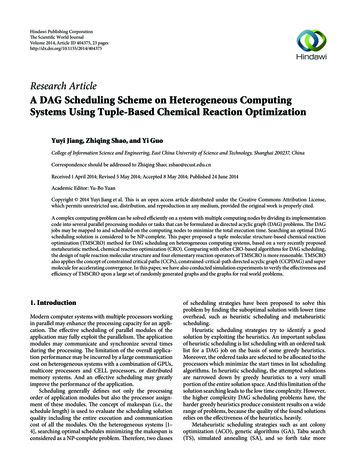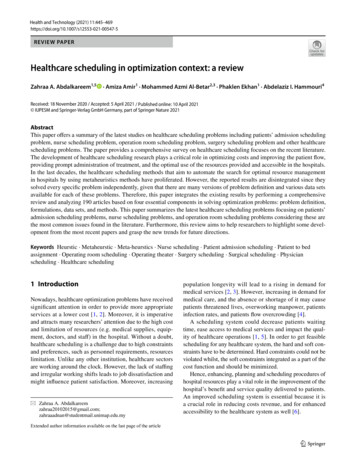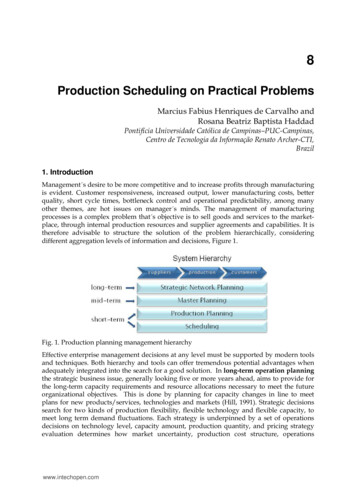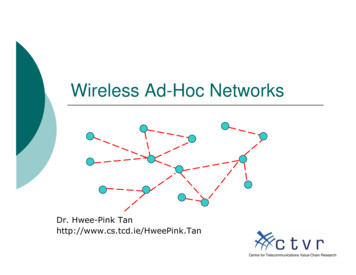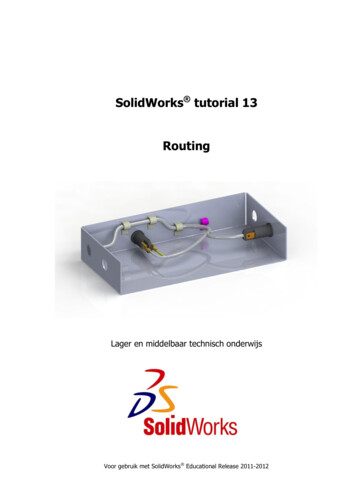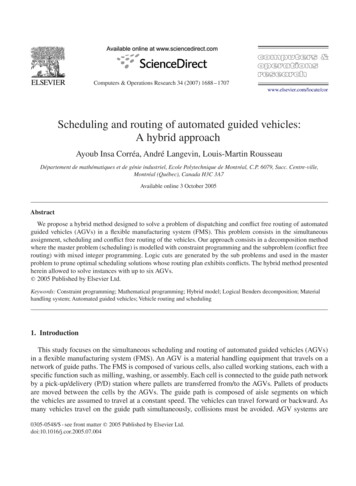
Transcription
Computers & Operations Research 34 (2007) 1688 – 1707www.elsevier.com/locate/corScheduling and routing of automated guided vehicles:A hybrid approachAyoub Insa Corréa, André Langevin, Louis-Martin RousseauDépartement de mathématiques et de génie industriel, Ecole Polytechnique de Montréal, C.P. 6079, Succ. Centre-ville,Montréal (Québec), Canada H3C 3A7Available online 3 October 2005AbstractWe propose a hybrid method designed to solve a problem of dispatching and conflict free routing of automatedguided vehicles (AGVs) in a flexible manufacturing system (FMS). This problem consists in the simultaneousassignment, scheduling and conflict free routing of the vehicles. Our approach consists in a decomposition methodwhere the master problem (scheduling) is modelled with constraint programming and the subproblem (conflict freerouting) with mixed integer programming. Logic cuts are generated by the sub problems and used in the masterproblem to prune optimal scheduling solutions whose routing plan exhibits conflicts. The hybrid method presentedherein allowed to solve instances with up to six AGVs.䉷 2005 Published by Elsevier Ltd.Keywords: Constraint programming; Mathematical programming; Hybrid model; Logical Benders decomposition; Materialhandling system; Automated guided vehicles; Vehicle routing and scheduling1. IntroductionThis study focuses on the simultaneous scheduling and routing of automated guided vehicles (AGVs)in a flexible manufacturing system (FMS). An AGV is a material handling equipment that travels on anetwork of guide paths. The FMS is composed of various cells, also called working stations, each with aspecific function such as milling, washing, or assembly. Each cell is connected to the guide path networkby a pick-up/delivery (P/D) station where pallets are transferred from/to the AGVs. Pallets of productsare moved between the cells by the AGVs. The guide path is composed of aisle segments on whichthe vehicles are assumed to travel at a constant speed. The vehicles can travel forward or backward. Asmany vehicles travel on the guide path simultaneously, collisions must be avoided. AGV systems are0305-0548/ - see front matter 䉷 2005 Published by Elsevier Ltd.doi:10.1016/j.cor.2005.07.004
A.I. Corréa et al. / Computers & Operations Research 34 (2007) 1688 – 17071689implemented in various industrial contexts: container terminals, part transportation in heavy industry,flexible manufacturing systems. For a general review on AGV problems, the reader is referred to [1–3].For a recent review on AGVs scheduling and routing problems and issues, the reader is referred to thesurvey of Qiu et al. [4]. These authors identified three types of algorithms for AGVs problems: (1) forgeneral path topology, (2) for path optimization and (3) for specific path topologies. Methods of the firsttype can be divided in three categories: (1a) static methods, where an entire path remains occupied untila vehicle completes its route; (1b) time-window based methods, where a path segment may be used bydifferent vehicles during different time-windows; and (1c) dynamic methods, where the utilization of anysegment of path is dynamically determined during routing rather than before as with categories (1a) and(1b). The method presented in this article belongs to the third category (1c) and addresses the conflictfree routing problem with an optimization approach. The plan of the article is as follows. Section 2presents a description of the problem. Section 3 reviews the relevant works. Section 4 presents the hybridconstraint programming (CP)/mixed integer programming (MIP) approach. Section 5 describes in detailthe experimentation. The conclusion follows.2. Problem descriptionEvery day, a list of orders is given, each order corresponding to a specific product to manufacture (here,product means one or many units of the same product). The product units are carried on pallets by theAGVs and the unit load is one pallet. Each order determines a sequence of operations on the various cells(machines) of the FMS. Fig. 1 presents the FMS with the AGV guide path used in the experimentation.The production scheduling, i.e., setting the earliest starting time of each machine operation for eachpallet of each order, is done a priori using the P.E.R.T. method. Hence, each material handling requestis composed of the pick-up and the delivery of a specific pallet with the corresponding earliest times.The guide path network is bi-directional. The vehicles can stop only at the ends (intersection nodes) ofthe guide path segments. There are two types of possible collisions: the first type may appear when twovehicles are moving toward the same node. The second type of collision occurs when two vehicles aretraveling head-to-head on a segment. A production delay is incurred when a load is delivered after itsplanned earliest time. The problem is thus defined as follows:Given a number of AGVs (and their starting positions) and a set of transportation requests, find theassignment of the requests to the vehicles and conflict free routes for the vehicles in order to minimizethe sum of the production delays.A solution of the problem determines: The number of AGVs required to perform the set of tasks.The assignment of requests to the AGVs.The position of each AGV at each period in the FMS.The schedule of each pick-up or delivery task.The revised schedule for each machine given the transportation schedule.Our problem may be seen as a vehicle routing problem with time windows (VRPTW) in which theobjective is to minimize the sum of deviations from the lower bound value of the time windows of the
1690A.I. Corréa et al. / Computers & Operations Research 34 (2007) 1688 – 3TURNING211817PRESS WORKINGFOUNDARYFig. 1. The FMS layout with the AGV guide path.delivery tasks subject to the following constraints: For each pick-up or delivery task, the lower bound of its associate time window is equal to its earliestprocessing time while the upper bound is the length of the horizon. There exist anti-collision constraints on nodes and arcs. There exist two types of precedence constraints between some specified pick-up and delivery tasks.The first type corresponds to a pick-up task that must immediately precede a delivery task on the samenode to satisfy the production sequence. The second type corresponds to a delivery that must precedea pick-up on the same node. A pallet has to be delivered and processed at a work station before beingavailable for a pick-up.
A.I. Corréa et al. / Computers & Operations Research 34 (2007) 1688 – 17071691 All nodes may be visited several times by the AGVs either to perform a task or for a simpletraversal.3. Literature reviewThis section is divided in three parts. In the first part, a review on AGVs scheduling and routing ispresented. In the second part, a brief description of the CP paradigm is intended for the OR researchersnot well acquainted with CP. The last part reviews the CP/MIP hybrid approaches.3.1. AGVs scheduling and routingA number of authors have addressed the conflict free routing problem with a static transportationrequests set, i.e., with all requests known a priori. Lee et al. [5] present a two-staged traffic controlscheme to solve a conflict free routing problem. Their heuristic method consists of generating off-linek-shortest paths in the first stage before the on-line traffic controller picks a conflict free shortest pathwhenever a dispatch command for an AGV is issued (second stage). Rajotia et al. [6] propose a semidynamic time window constrained routing strategy. They use the notions of reserved and free timewindows to manage the motion of vehicles. Krishnamurthy et al. [7] propose an optimization approach.Their objective is to minimize the makespan. They assume that the assignment of tasks to AGVs is givenand they solve the routing problem by column generation. Their method generates very good solutionsin spite of the fact that it is not optimal (column generation is performed at the root node of the searchtree only). Oboth et al. [8] present a heuristic method to solve the dispatching and routing problems butnot simultaneously. Scheduling is performed first and a sequential path generation heuristic (SPG) isused to generate conflict free routes. The SPG is inspired from Krishnamurthy et al. [7] static versionof the AGV routing problem and applied to a dynamic environment while relaxing some of the limitingassumptions like equal and constant speeds of AGVs. When conflict is encountered, no feed back is sent tothe scheduling module. The AGV being routed has to be delayed if an alternate route cannot be generated.The authors use rules for positioning idle AGVs instead of letting the system manage them. Langevin etal. [9] propose a dynamic programming based method to solve exactly instances with two vehicles. Theysolve the combined problem of dispatching and conflict free routing. Desaulniers et al. [10] propose anexact method that enables to solve instances with up to four vehicles. Their approach combines a greedysearch heuristic (to find a feasible solution and set bound on delays), column generation and a branchand cut procedure. Their method presents however some limits since its efficiency depends highly onthe performance of the starting heuristic. If no feasible solution is found by the search heuristic, thenno optimal solution can be found. The search heuristic performs poorly when the level of congestionincreases.3.2. The CP paradigmConstraint programming, which has been very successful in solving hard combinatorial problems inthe field of scheduling, planning, and transportation [11–13] the subject of several textbooks [14–17].Traditionally a constraint programming model is composed of a set of variables (X), a set of domains(D), and a set of constraints (C) specifying which assignments of values in D to variable X are legal. The
1692A.I. Corréa et al. / Computers & Operations Research 34 (2007) 1688 – 1707efficiency of the constraint programming paradigm lies in powerful constraint propagation algorithmswhich remove from the domain of the variables the values which will generate infeasible solutions. Ifconstraint propagation is not sufficient to find a feasible solution then a branching process is performed tofurther narrow the domains; a feasible solution is found when each domain contains only one value. Thebranching process is necessary in most difficult combinatorial problems. Typically, at each node of thesearch tree the following steps are taken: first a variable not yet fixed is selected and a remaining valueof its domain is assigned to it. Then constraint propagation occurs. If during propagation the domain of avariable is emptied then the solver has detected an inconsistency in the previously taken decisions and thewhole search process backtracks, typically by choosing another value for the variable. When constraintpropagation terminates while there are still some unfixed variable, then the solver creates a new searchnode and goes on with the procedure just detailed. The branching strategy is thus defined by variableand value selection policies. This is the most simple and frequently used branching strategy but moreintricate policies are often used. For instance one could split the domain of a variable into to two sets ofsimilar size or even use two opposing constraints to define two branching directions. It is fairly simple toextend this method to solve combinatorial optimization problems, that is to identify the feasible solutionwhich minimizes (or maximizes) a given objective function. Once a feasible solution as been identified,the set C is extended to contain a new constraint specifying that future feasible solutions should have astrictly better cost than the cost of the solution just identified. The solver thus keeps searching for bettersolutions until it can prove that the last found is optimal.3.3. CP/MIP hybrid approachesHooker and Ottosson [18] and Milano [19] present comprehensive reviews on hybrid methods. We focushere on the more relevant works. Hooker [20] gives insights on how CP can be integrated to Bendersdecomposition. A number of researchers have integrated CP in the classical Benders decomposition forMIP (the master problem or the sub problem is formulated in CP and logic – no goods – cuts are used).Benoist et al. [21] formulate their master problem as a CP model. Their master problem is reduced toa global constraint whereas the sub problems use linear duality. The global constraint uses the networkstructure of the original problem and consists of two types of equations defining the feasible flow problem.This method has been efficiently applied to a workforce scheduling problem in a telecommunicationscompany call center. Eremin and Wallace [22] also present a hybrid decomposition method in which themaster problem is solved with CP. The major interest of their approach is that the user only needs tospecify the variables of each sub problem. This enables the automatic derivation of the dual form of eachsub problem and an automatic extraction of the Benders decomposition. It can help researchers focus onCP or mathematical programming (not both fields) for quickly designing prototypes of models.In other papers, the master problem is solved with MIP and sub problems are formulated and solvedwith CP. Thorsteinsson [23] proposes a hybrid framework that encapsulates Benders decomposition asa special case. Jain and Grossmann [24] use a MIP/CP decomposition method in which the masterMIP model is a relaxation of the original model and feasibility sub problems are solved with CP. Theyproposed also a LP/CP-based branch-and-bound algorithm to solve their hybrid models. Their applicationexample is a scheduling problem of dissimilar parallel machines. In the same line of research, the paperof Maravelias and Grossmann [25] presents a conceptual similarity with our decomposition. Their masterMIP is a relaxation of the original problem. Then given a relaxed solution, the CP sub problem checkswhether there exists a feasible solution and generates integer cuts. This method is used to solve a batch
A.I. Corréa et al. / Computers & Operations Research 34 (2007) 1688 – 17071693chemical process problem. As an extension of the previous approach, Hooker [26] uses a hybrid MIP/CPdecomposition method to solve a class of planning and scheduling problems for manufacturing and supplychain management. This method, named logic-based Benders decomposition, exploits the strengths ofMIP in the assignment portion and CP to tackle the scheduling part. Tasks are assigned to facilities byusing MIP and then scheduled subject to release dates and deadlines using CP. The cuts used are basedon either the information on the sets of tasks assigned to facilities (in case of cost minimization) or theinformation on the makespan (in case of makespan minimization).4. A hybrid CP/MIP approachThe development of our approach stems from the limitation of a previous mathematical programmingapproach [10] as discussed in Section 3.1. The basic motivation for this CP/MIP decomposition is tobenefit from the strengths of CP for scheduling (as it can handle nonlinear constraint) and of MIP forrouting in this particular context. The approach is inspired by the logic-based Benders decomposition[18] although it does not take advantage of duality. Section 4.1 presents the decomposition framework,while in Sections 4.2 and 4.3, the master and the sub problem models are respectively described. Section4.4 discusses the logic cuts generated from the sub problems.4.1. The decomposition frameworkIn the decomposition method developed herein, the CP master problem determines both the assignmentof the transportation requests to the vehicles and the schedule (i.e., the expected times) of the pick-up andthe deliveries based on the shortest path routes (neglecting the possible route conflicts). For each solutionof the master problem, the MIP sub problem tries to find collision free routes satisfying the scheduleobtained from the master problem. When there are no solution (i.e., it is not possible to find conflict freeroutes that satisfy the schedule), logic cuts are generated and sent back to the master problem. The methodis depicted in Fig. 2.The logic cuts (described in detail in Section 4.3) are constraints added to the model to eliminate theCP solutions that have no feasible routing solution (both the incumbent and as many as possible other CPsolutions with the same objective value (total delay)). One cut consists of a disjunction of three options:with the first two options, the same assignment of requests to the AGVs is kept but either the transportationtime or the starting time of at least one delivery is increased by one unit, the third option consists in makinga change to the assignment of requests to the AGVs (at least one request must be reassigned).The CP master problem provides a very good lower bound to the original scheduling and routingproblem and it contains essentially nonlinear constraints. The sub problem has a very strong minimumcost flow problem structure and thus can be solved efficiently by the network simplex (together withB&B).4.2. The CP modelThe model determines which vehicle will be processing what material handling request at what timeby generating an ordered assignment of tasks to AGVs while minimizing the total number of deliverydelays. The total amount of delays is measured by summing the difference between the planned start time
1694A.I. Corréa et al. / Computers & Operations Research 34 (2007) 1688 – 1707Fig. 2. The hybrid method.and the earliest start time of each delivery. In this model, the distance (time) matrix is obtained by usingshortest paths between nodes. Thus, the delays calculated (which do not take into account the possibleconflicts) provide a lower bound of the actual delays. A transportation request consists of a pick-up anda delivery tasks. For modeling purposes, dummy start and end requests (and tasks) are associated witheach AGV. If the successor of a dummy start request is the dummy end request corresponding to thesame vehicle, it means that the AGV is not used during the whole horizon. In addition, we assume that adummy start task corresponds to a delivery task of the preceding horizon. Hence the starting (beginningof the horizon) and final (end of the horizon) positions can be seen as dummy task nodes for each AGVfor the current horizon and the next one. We define the set W as the set of all tasks including the dummystart ones.Sets and parameters of the CP modelWset of pick-up and delivery taskspWset of pick-up tasksWdset of delivery tasksVset of AGVsRset of requests: each is a pair of pick-up (r p ) and delivery (r d )Tthe set of time periodsIset containing R and the dummy start requestsOset containing R and the dummy end requests
A.I. Corréa et al. / Computers & Operations Research 34 (2007) 1688 – 1707PEe(·)D(·, ·)ninv1695set of couples of tasks linked by a precedence relationship (p 1 , p2 )the set of all earliest start timeduration of the processing at a workstationlength of the shortest path between the nodes of two tasksthe node for task ithe starting node of AGV vVariables of the CP modelvr V variable representing the AGV assigned to request rsr O variable representing the request performed immediately after r on the samevehicletr Tvariable representing the start time of request rThe objective function consists in minimizing the sum of the differences between the given earlieststarting times and the actual starting time of the deliveries (the tr ) variables. The constraints used in themodel are the following (for concision, we have not included the starting and ending conditions whichare straightforward):Min (tj Ej )(1)j W ds.t.vo vso o O,tr p 1 D(r p , r d ) tr d r R,psr1 r2 tr d 1 D(r1d , r2 ) tr p21 (tp1 ti tp2 )tp1 1 tp2(2)(3)(4) r1 , r2 R, p P , i W : (p1 , p2 i (ni np1 np2 ), p P : (p W ) (p W ),12pd(6)tp1 1 ep1 tp2 p P : (p W ) (p W ),(ti tj 1) (ti 1 tj ) i, j W : (i j ) (ni nj ).1d2(5)p(7)(8)Constraints (2) ensure that each request and its successor are assigned to the same AGV. Constraints (3)specify that each vehicle processing a request must have enough time to go from the request pick-up nodeto the related delivery node. Constraints (4) ensure that if one request is the successor of another requeston the same vehicle, the AGV must have enough time for dead-heading. Constraints (5) enforce that iftwo tasks linked by a priority constraint share the same node, they must be processed consecutively atthis node. Constraints (6) state that at least one period (duration of the pick-up) must elapse between thestarting times of pick-up and delivery tasks linked by a priority constraint. Furthermore, no other task canbe performed on a node between the execution of two tasks linked by a priority constraint (more detailsare given in Section 4.1). Constraints (7) ensure that, if a delivery precedes a pick-up, there is at least oneperiod (duration of the delivery) plus the processing time of the delivered product between their startingtimes. Constraints (8) ensure that two different tasks cannot start at the same node at the same time.Search strategy. To help the CP model, we implemented some selection heuristics used in combinationto the pre-implemented slice-based search (SBS), a technique similar to limited discrepancy search (LDS)(see [27]). In fact SBS determines the shape of the branching tree while our heuristics specify how tomove inside the tree. The basic idea behind SBS (or LDS) is to minimize the number of decisions that
1696A.I. Corréa et al. / Computers & Operations Research 34 (2007) 1688 – 1707Fig. 3. Time-space network.do not respect the heuristic first choices. To implement this search, one needs a selection heuristic thatranks all branches of a node. Then at each node of the search tree, a discrepancy is counted each timea branch, not ranked first, is taken. The overall process thus starts by traversing the search tree withoutallowing any discrepancy, and then it iteratively increases the number of discrepancies tolerated andtraverses the search space again. The description of our heuristic procedure is as follows: variables arechosen according to a first-fail strategy, i.e., the variable with the smallest domain is instantiated first.Regarding the order of values for the instantiation of the variables, the following strategy was used: forthe v variables, similar requests (same pick-up node and same delivery node) are assigned as much aspossible to the same AGV, the closest AGV to the pick-up node being chosen first. The t and s variablesare instantiated to values in increasing order.4.3. The MIP modelSince an AGV may visit an arc or a node more than once during the horizon, a time-space graph wasused to model the routing of the AGVs. The time-space graph is illustrated in Fig. 3 and can be described asfollows: a node is defined for each period (of one time unit) and each endpoint of the guide path segmentsof the FMS. Each node of a given period is linked by arcs to the corresponding adjacent nodes of thenext period. Those arcs correspond to the movement of an AGV between two adjacent endpoints of thesegments of the guide path. Each node of a given period is also linked by an arc to the corresponding samenode of the next period (i.e., a horizontal arc). This corresponds to waiting one unit of time at that node.There are no arcs between nodes of a same period. All arcs of the graph have a length of one time unit.For each AGV, there is a starting node at period 0. The problem corresponds then to a multi-commoditynetwork flow model where each commodity represents one vehicle. The master problem solution imposesthat each flow visits specific nodes at specific times.Sets and parameters of the MIP modelVset of AGVsNset of nodesTset of all time periodsT set of all time periods but the first
A.I. Corréa et al. / Computers & Operations Research 34 (2007) 1688 – 1707AA Af [.]At [.]Aw [.]Ao [.]nvWv, tRR [., t]1697set of arcsset of all arcs (including waiting arcs)the set of arcs coming from node ithe set of arcs entering in node ithe waiting arc associated to each nodethe opposite arc of each arcthe starting node of AGV varray of records describing each a task with two fields (node, earliesttime)data obtained from the CP modelset of requests: each is a pair of pick-up (r p ) and delivery (r d )for every pair of (node i, period t), set of pick-up and delivery tasks r whoseservice node are i and which are performed at time t ((t tr 1) (i nr ))Variables of the MIP modeltBoolean variable 1 if AGV k starts traversing arc a at period t and 0 otherwise.Xk,aSince we only search for a feasible solution the objective function is irrelevant, we thus used a constantobjective function. The model is the following:Mins.t.1 (9)oXk,a 1 k V ,(10)a Af [nk ] tXk,a 1 t T , k V ,a A ttXk,a Xk,a 0 i tfainA [i]a A [i] ttXk,a Xk,A t T ,o [a] 1k Vk VTpXVrr ,Aw [n p ] 1 r R,rTr dXVr ,Aw [n d ] 1 r R,r k V ,a At [i] tXk,a 1 r R [t 1,i] (11)N, k V , t [1 . . . (M 1)],(12)a A,(13)(14) 1 (15) 1 i N, t T .(16)r R [t,i]Constraints (10) ensure that each AGV is located at its initial position at the beginning of the horizonwhile constraints (11) ensure that each AGV is located at a unique position at each period. Constraints(12) are flow conservation constraints. Constraints (13) are collision avoidance constraints. Constraints(14) state that every pick-up task must be done by the right vehicle at the right time while constraints (15)are the equivalent of constraints (14) for delivery tasks. Constraints (16) are node capacity constraintsstating that there can be only one AGV on a node at any time except the case where one AGV leaves anode task while another one is just entering in the same node task (that’s why the product of the sums isadded to the right hand side of constraints (16)). If the above MIP has a feasible solution then optimalityfor the global problem is obtained. Otherwise, cuts are added to the master problem which is re-solved.
1698A.I. Corréa et al. / Computers & Operations Research 34 (2007) 1688 – 17074.4. Logic cutsAs there are many different solutions to the scheduling model with the same production delay, theobjective is to define cuts which forbid not only the current infeasible (i.e., conflicting) solution but asmany other solutions exhibiting the same undesired properties. The logic cuts, generated when no feasiblerouting can be found, are based on the starting times of deliveries and the assignments of requests to AGVs.The intuition behind the presented cuts is that when a conflict occurs between two AGVs, at least one ofthem does not have enough time to fulfill its next task.In addition to the parameters and sets defined in the CP model, the following ones are used:tj vj sj the current optimal starting time of task jthe current optimal vehicle assigned to rthe current optimal successor of request rThe cuts generated in this approach are essentially feasibility cuts. When a conflict arise in the routingmodel, it means that the duration of at least one trip (material handling or deadhead) is too short. To correctthis situation it is thus necessary to either change at least one starting time of a task (pick-up/delivery) orchange the assignments of transportation requests to AGVs. A logic cut consists of a disjunction of thethree following constraints: Keep the assignment of requests to AGVs and increase the time of routing between the pick-up andthe delivery of a same request. This corresponds to extending at least by one period the time windowbetween a pick-up and a delivery. This constraint can be written as (vr vr ) R V ((tr d tr p ) (tr d tr p )) 1 .r Or R OR keep the assignment of requests to AGVs and the time of routing between the pick-up and thedelivery of each request but increase the starting time of some tasks. This corresponds to delaying atleast one request, namely (vr vr ) R V (tr d Sr d ) R 1 .r Or R OR change the assignments of requests to AGVs. (vr vr ) R V 1 .r O5. ExperimentationThis section presents the computational experiments. We first describe the instances used for the testsand then we report the results. Finally, we discuss some additional features of the method that wereexplored.
A.I. Corréa et al. / Computers & Operations Research 34 (2007) 1688 – 17071699Table 1Description of the problem setsProblem setCategoryNumber of requestsNumber of precedence pactCompactCompactSpread outSpread outSpread outSpread outSpread outSpread outSpread 89675.1. The instancesThe FMS used for the experiments is presented in Fig. 1. The guide path was divided into segments of7.5 m. Assuming that the AGVs move at a constant speed of 0.5 m/s, these segments are therefore traveledin 15 s, which corresponds to one time unit. The instances we used are built from the data set of Desaulnierset al. [10] using 12 different request sets from several orders of an order book. The details of the orderbook can be found in [9,28]. A planned production schedule based on average material handling timesprovides the processing times at the work station, the earliest processing start time, and the processingtime, as well as the precedence relationships to satisfy for each pair of operation and part type. The numberof transportation requests in those 12 sets varies from 7 to 10. There are two categories of sets, differingby the spatial density of the requests. The first category,
handling system; Automated guided vehicles; Vehicle routing and scheduling 1. Introduction This study focuses on the simultaneous scheduling and routing of automated guided vehicles (AGVs) in a flexible manufacturing system (FMS). An AGV is a material handling equipment that travels on a network of guide paths.
